This was published 1 year ago
South-East Asia’s version of the Orient Express is back, better than ever
By Penny Watson
On a 15-carriage train, where my car F is 12 carriages from the piano bar, a certain knack is required for walking while the train is trundling along at 90km/h. I master a technique that necessitates a hand on each wall and a step-stop-step balancing act with my shoulders taking the weight when the slim, narrow-gauge track curves and the carriage leans.
On one occasion, a fellow passenger pops out of a cabin up ahead, nods his hello and takes the lead, heaving open the twin set of heavy wooden sliding doors between each carriage so that we can both slip through before the doors roll themselves shut with a weighty bang.
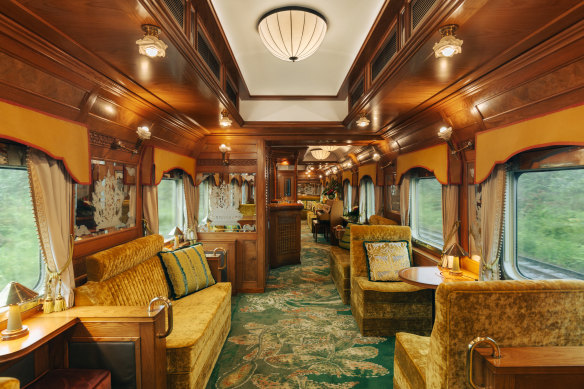
The sumptuous piano bar on board the Eastern & Oriental Express.Credit: Ludovic Balay
Such is the length of the train and the shared purpose of getting to the piano bar, the interaction results in a pleasant tete-a-tete as we continue single file. In fact, it is as good as any confessional, with life’s big questions culminating in the final reveal: we could both murder a drink.
Murdering anything is entirely on theme aboard Belmond’s Eastern & Oriental Express. This is the sister train of the famed Orient Express, on which Agatha Christie’s novel Murder on the Orient Express and the acclaimed film of the same name was set. I can well imagine detective Hercule Poirot engaging his suspects in similarly probing conversation as they pass through the carpeted carriages, the palm trees blurred green out the window.
A berth on the E&O Express has been in my sights since travelling in Thailand’s Kanchanaburi Province about 15 years ago. As I walked alongside the Burma Railway track, exploring the harrowing history of the railroad built by World War II prisoners of war, the E&O Express ambled past us like an automotive goddess, the regal green of her carriages gleaming in the tropical sunlight, her tasselled curtains parted like eyelids to share a glimpse of passengers sitting either side of lamplit dining tables.
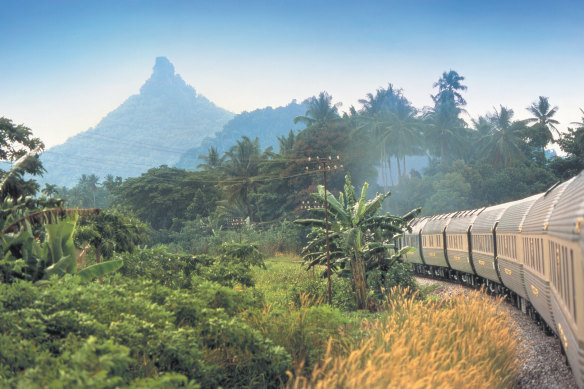
The 15-carriage Eastern & Oriental.
The Orient Express, running between Paris and Istanbul, started service in 1883 and operated until 1977 (after which its descendent train, Belmond’s Venice-Simplon Orient Express started service). The E&O Express launched much later. Its stainless steel carriages were built in Japan in the early 1970s for a short-lived tenure as New Zealand’s Silver Star sleeper train. In the early ’90s, the rolling stock was shipped to Singapore to be reincarnated. In 1993, the E&O Express joined the ranks of luxury rail experiences and became the first train to expressly service the Singapore-Kuala Lumpur-Bangkok route.
The E&O Express might not have the same longevity and history as the original Orient Express, but the five-star service and opulent decor has a similarly storied and spirited appeal that effortlessly channels the romanticism and nostalgia of a golden era in train travel.
For those keen to dabble in its extravagances, the dream lives on. During a three-year pandemic-induced hiatus, the E&O Express was sumptuously restyled. Its 15 beautiful carriages retain the gorgeous inlaid rosewood, cherry and elm marquetry panelling of old, but its interiors have been lavishly restyled with exquisite fabrics, upholstered furnishings, golden handles and hooks and exotic Asian motifs.
Back on track in March, it is now servicing the Malay Peninsula on two forked-tongued return journeys that run from Singapore north to Penang Island or Alor Setar (near Langkawi) on the west coast, back to Gemas, then north again to Merapoh and Kota Baru on the east coast.
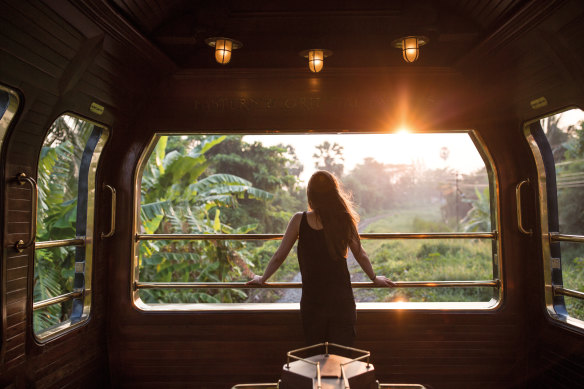
The view from the caboose on Belmond’s sumptuously restyled train.
I’m on the Wild Malaysia itinerary, a three-night journey with stops at regional Merapoh Station where passengers disembark for a choice of excursions: on the back of a ute to explore the rolling hills of Taman Negara National Park or on electric bikes through tangled jungle to the Merapoh Caves. And, again at Butterworth Station to board a ferry to Penang Island, for Vespa or rickshaw rides around Georgetown, the UNESCO World Heritage Site with ornamented shophouses, colourful temples and onion-topped mosques that are a nod to the region’s Chinese, Malay and Indian communities.
The journey begins at Malaysia’s Woodlands Station, the border checkpoint near Singapore, where, straight after immigration, I spot the E&O Express curved along the platform behind a big old diesel engine, a line of smartly attired porters ready to welcome passengers on board.
Vishnu, my personal steward, who rather marvellously refers to himself as J.P. Vishnu, escorts me to my state cabin, the second of the train’s three sleeping categories. It’s a delight, with interiors in the tradition of Asia’s illustrious heritage hotels including Singapore’s Raffles, and Penang’s Eastern & Oriental, from which the train’s name was originally borrowed.
The teak and velvety blue-covered couch, which will be converted to a bed come nighttime, is pimped with silken green dragon imprinted cushions and luxurious hibiscus patterned carpet. There’s a lounge chair for breakfasting and a petite ensuite with a mosaic of floor tiles, wooden cabinetry, marble sink and shower. The pelmets and pouffes are all pipe-edged and pretty and the curtains are held back by colourful cords so that I can see the station disappearing as the journey begins.
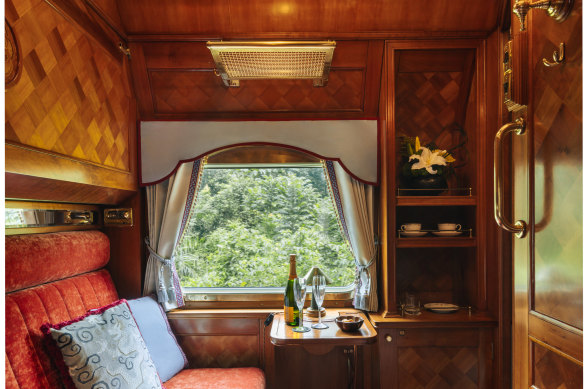
Inside a sleeper cabin.Credit: Ludovic Balay
J.P. Vishnu opens cupboards and draws secreted away behind the smooth wall panelling revealing places to slot shoes and bags and other travelling accoutrements. A slim cupboard proves ideal for long dresses, which I am happy to have packed. As the train moves slowly out of the city, guest services announces that: “The ambience of the train provides a marvellous opportunity to display some glamour and style, and dressing up is encouraged…”
Hoorah!
Two carriages down from mine, the bar car is similarly luxuriantly appointed with silk fabrics, timber pelmets, polished rattan furniture panels and wooden floorboards softened by a handsome floor runner. Traditional crispy Indian snacks are served alongside silver teapots and embroidered napkins featuring the tiger insignia. From the bar I step outside to the tropical heat and humidity of the observation car, a loveable caboose where a central row of back-to-back bench seats ensures comfortable passage as the train blows the trackside palm trees into a state of confusion.
The scenery shapeshifts between haughty rows of palm and rubber plantations and little villages with simple corrugate and concrete houses and primary coloured rooftops – what’s left of the tin mining communities originally serviced by this railway.
In the evenings, J.P. Vishnu leaves a little calling card in my room detailing my dinner arrangements. A green card indicates dinner will be in Adisorn restaurant, with its florally green upholstered French chairs. A red card says I’m off to the Malaya car, with its amber-hued fabrics and cases of orchids so pretty they look fake. Both dining cars enjoy an aperitif-primed atmosphere where the jingle-jangle of silverware and the tinkle of cut glass are a match for the infectious laughter and excitable chatter that preludes a three-course meal.
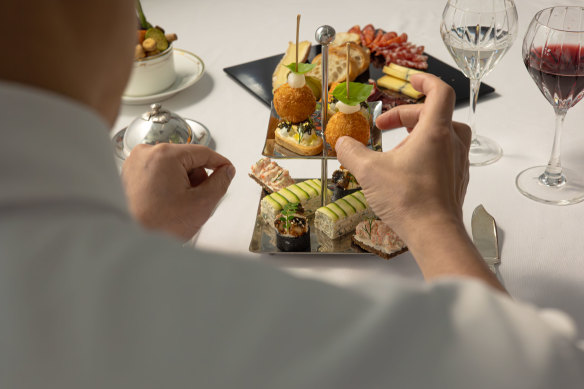
Food by culinary curator, Andre Chiang.
The dining staff are immaculate and charismatic too, welcoming guests to their seats like maitre d’s of old. The culinary curator, on the other hand, is of the day. Taiwanese-born chef Andre Chiang has made a celebrity of himself in Singapore with his eponymous Restaurant Andre earning two Michelin stars and a place in the World’s 50 Best Restaurants. He now runs what must be one of the world’s smallest kitchens. A sneak passing peek reveals a hubbub that hisses and steams like a culinary magic show.
At dinner, Chiang, who counts both France and Japan as culinary influences, explains his modern take on South-East Asian cuisine.
“Does a piece of steak or a scallop remind us of where we are?” he asks.
“No, it’s the spices… On this journey I invite you to close your eyes and try to figure out where the spice comes from and where they are taking us to.″
It’s a neat little mealtime prompt that I use to detect the miso in the shrimp and clam bouillabaisse, the kimchi in the nicoise, the Sichuan green pepper in the chicken soup. Even the star anise in the Chinese braised pork belly sings.
Or is that just the piano bar calling? After dinner, here we are again, luxuriating in the velvety yellow banquet seats while being entertained by dazzling jazz singer Janet Lee and Cher Siang, a pianist who tinkles away with a contented smile. Veuve Clicquot free-flows and a cocktail list, beautifully styled like a children’s pop-up book, is being passed around for those who prefer negronis to champagne.
If heading to the piano bar was a bonding experience, returning to our cabins is a conga line of happy people performing the step-stop-stumble when the carriage leans.
Back in my cabin, J.P. Vishnu has prepared P.J. Watson’s bed. The couch is now a cosy place plumped with white pillows sporting the E&O insignia. Slippers and a dressing gown lay in wait and the bedside lamp is dimmed just so. I read for two, maybe three, minutes before the marvellous rumbling rhythm of the train rocks me to sleep.
THE DETAILS
The Eastern & Oriental Express, A Belmond Train, South-East Asia’s three-night Wild Malaysia itinerary starts at $US3410 ($5125) a person and includes all meals, a selection of alcoholic and non-alcoholic drinks, onboard entertainment and activities. See visitbelmond.com
The writer was a guest of Belmond.
Sign up for the Traveller Deals newsletter
Get exclusive travel deals delivered straight to your inbox. Sign up now.